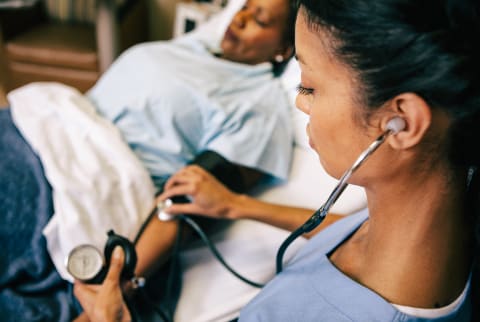Advertisement
How To Actually Measure Your Blood Pressure At Home, From An MD


PSA: Your blood pressure is probably inaccurate
Given the medical-grade equipment and expert-led protocol, why wouldn’t the measurement at your doctor’s office be the most accurate? Well, according to Attia, the explanation is twofold. “When you go to the doctor’s office, you’re not really getting an accurate blood pressure,” he declares.
Firstly, you’re probably a bit nervous. “You’re very susceptible to ‘white coat hypertension1,’” Attia calls it. Essentially, the nervous energy simply from being at the doctor can easily skew your results.
“Even if you’re not [nervous], rarely is a protocol correctly used for measuring blood pressure,” Attia continues. Now, this isn’t to fault your doctor who is likely doing the best they can with the time and situation at-hand.
Still, you’re likely not in the best state for an accurate read. Firstly, your arm has to be at the exact same level as your heart: “It can’t be above it; it can’t be below it,” Attia notes. Your legs should also remain uncrossed—a detail some practitioners may forget during their rounds.
What’s more, a rest period pre-measure is essential: “You need to be resting for five minutes before you get your blood pressure checked,” Attia says. This means no talking, no movement, and a clear mind (read: no nervous thoughts).
In Attia’s practice, the most successful readings have actually been those that patients conduct at home. So he recommends measuring your blood pressure with an at-home device, if you can, and keeping a log.
How to measure blood pressure at home
While you by no means must measure your blood pressure every day for the rest of your life, it’s a good idea to be consistent with it for a while so you know your unique baseline for comparative purposes. Here's how to measure it:
- Get a monitor: First, you’ll need a trusted blood pressure monitor. To ensure your monitor is a worthy purchase, look through this list from ValidateBP for validated devices (spoiler: The A&D monitor fits the bill!).
- Stay consistent: Attia recommends measuring your blood pressure every day, twice a day. Make sure to have a five minute rest period, line up your arm with your heart, never measure when you’re nervous or stressed, and always keep your legs uncrossed.
- Keep a journal: Write down your blood pressure in a journal every time you measure. This way, you can identify your base readings and have it on-hand should you want to share it with your doctor.
How to manage blood pressure
Want to lower your blood pressure? Don't worry; managing your levels doesn’t need to be extremely complicated. For general healthy blood pressure tips, see below:
- Exercise: Research shows that regular exercise can help manage blood pressure2. This doesn’t mean you have to pick up running if you hate it; just commit to exercising a few times a week in any way you like. (We always say that the best exercise is the one that you'll do!)
- Eat a balanced diet: According to the National Center for Biotechnology Information (NCBI)3, “The strongest evidence for lowering blood pressure or preventing hypertension through dietary intervention includes adopting a dietary pattern such as the DASH diet or a Mediterranean diet, eating less saturated fat and total fat, getting plenty of potassium, limiting the amount of sodium in the diet, and limiting alcohol consumption.”
- Prioritize omega-3’s: As the FDA notes, consuming omega-3’s (both EPA and DHA forms) has been shown to lower blood pressure and reduce the risk of hypertension. To be sure you get enough, consider an omega-3 heart supplement—here are a few worthwhile options to consider.
The takeaway
If you want to feel confident in your blood pressure measurement, you may want to opt for consistent at-home tests using an authenticated monitor. At the very least, keep Attia's tips in mind when getting a reading at your doctor check-ups.
Then to keep your blood pressure balanced, create a consistent exercise routine, consume healthy foods, and of course, prioritize omega-3’s.